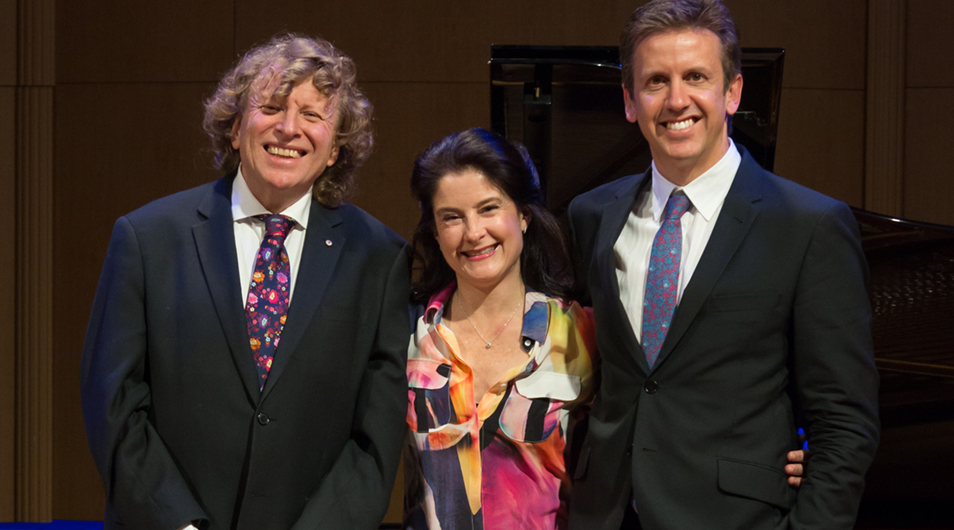Llewellyn Hall, ANU, Canberra
July 18, 2018
Johannes Brahms didn’t really want any fanfares when the University of Breslau, in Poland, told him he would be awarded an honorary doctorate in 1879. He would have been quite happy to write a “thank you” note. Thankfully for us, 140 years on, he was persuaded to write his Academic Festival Overture instead. He conducted its premiere at the conferring ceremony in January 1881.
It’s not the serious, stately piece one might expect at such a solemn, if celebratory, occasion; quite the opposite – an arrangement of student drinking songs. And Brahms must have smiled broadly when he wrote the soft and solemn opening. Martin Buzacott, in his notes published in the program booklet for this concert, says that students liked it so much they “began singing their own obscene versions of the words” during the performance!
Brahms’ masterful orchestration underscores his humour, but also gives the work an intellectual quality that makes it enjoyable for orchestra and listener alike. Conducting from memory, Nicholas Milton and the Canberra Symphony Orchestra proved that quality to be true. Milton’s style might be exuberant – some would say theatrical – but very expressive. He immerses himself and his orchestra into the music fully, teasing out beautiful balance and tone to reveal extraordinary expression and phrasing, and creating nuances not heard elsewhere.
 Pianist Piers Lane, violinist Dimity Hall and Canberra Symphony Orchestra Artist-in-Focus, cellist Julian Smiles
Pianist Piers Lane, violinist Dimity Hall and Canberra Symphony Orchestra Artist-in-Focus, cellist Julian Smiles
This was especially so in Beethoven’s Op. 56 triple concerto, featuring violinist Dimity Hall, cellist Julian Smiles (also the CSO’s artist-in-focus this year), and pianist Piers Lane. It is quite unlike the drama of many of Beethoven’s other works. The drama in this work is much more understated, giving way to the most intricate, often subtle, interactions between the three soloists.
Beethoven could have called this work a concerto for piano trio and orchestra, such is the way the solo parts interweave, with the orchestra filling out the sound, reinforcing the solo passages and providing the most delicate accompaniment. The soloists and the ever-attentive Milton did all of that brilliantly. It was as much a joy for the eyes to look for the sound source as it was for the ears to hear it.
It wasn’t until English composer, Edward Elgar, was 40 years of age that he really started to shine in his craft. And that was when he wrote his Op. 36, the so-called Enigma Variations. Based on what he called a well-known theme, which he refused ever to reveal, making it the subject of debate right up to today – hence Enigma – the piece comprises 13 movements, each one dedicated to a friend “pictured within,” he said, with a 14th being a self-portrait. (What better gift for a composer to give a friend than to write a piece of music for them?) Like the Brahms heard earlier in the program, this work has humour and wit, drama and romance.
Of course, the most famous movement is the ninth – Nimrod – for Elgar’s friend and publisher, August Johannes Jaeger. In this there is some of Elgar’s wit: Nimrod is the mighty hunter of Genesis Chapter 10, and Jaeger is German for “hunter”. But the movement is cast with music and orchestration that is quintessentially of the Romantic period, full of richness, slowly building the sound from the softest strings to full-bore brass and percussion.
The CSO and Milton, again conducting from memory, gave energetic life, colour and animation to Elgar’s humour, wit, drama and romance from beginning to end. Without doubt, this was the most satisfying performance of the Enigma Variations I have heard – ever.
The audience thought so, too, whistling and hooting as an audience might at a rock concert, inspiring the orchestra to give an encore – another piece by Elgar, his famous Pomp and Circumstance March No. 1, in which the trio is Land of Hope and Glory. Milton took the outer march sections at a gallop, with the trio being full and rich.
More whistling and whooping from the audience brought this very engaging concert to a conclusion.
The Canberra Symphony Orchestra’s ActewAGL Llewellyn Three plays again tonight at Llewellyn Hall.











Comments
Log in to join the conversation.